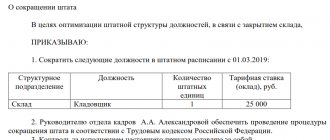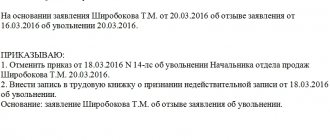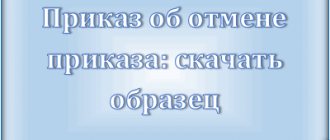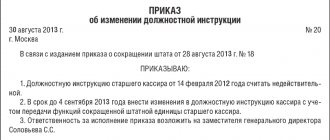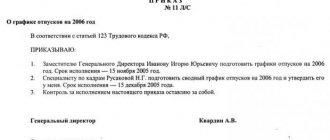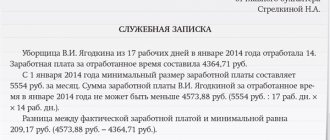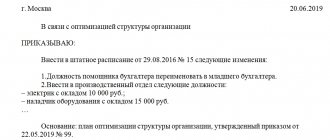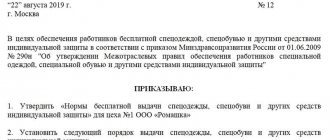An order is the main administrative document of an enterprise. In the nomenclature of an organization’s affairs, the issuance of such orders is usually divided into two large groups: by main activity and by personnel. Let's look at the first group.
We are talking about local regulatory documents that reflect management decisions on issues of production and economic activity, planning, reporting, financing, lending, sales of goods, etc. As a rule, a local regulatory act is prepared by the structural unit whose activities are related to its implementation. In the article we will provide sample orders for the main activities of the enterprise, which can be used in everyday work.
Among orders on core activities (OA), a special place is occupied by orders on administrative-organizational or administrative-economic issues. They must be stored separately as they have different shelf life. If orders on ML are stored permanently, then on administrative and economic issues - 5 years.
Orders on main activities
Often, clerks have difficulties with how to correctly write an order, and with attributing the order to local regulations on ML or on personnel. The basic principle is as follows: if the order form regulates labor relations with the organization of specific employees, this is an order regarding personnel (hiring, dismissal, leave, business trip, promotion, discipline, training, etc.), but if we are talking about the organization as a whole, this is an order for the main activity, even if it names responsible persons and gives instructions to specific employees.
Here is a far from complete list of ML orders. These include the following orders:
- about taking on the position of a manager;
- on assigning the duties of chief accountant to the manager;
- on the appointment of an interim manager;
- on granting the right to sign;
- on the appointment of a person responsible for maintaining, storing, recording and issuing work books;
- on the transfer of functions for maintaining personnel records to an outsourcing company;
- on the appointment of a person responsible for ensuring fire safety in the building;
- on approval of the staffing table;
- on the creation of a separate division;
- on the introduction into force of a new edition of the “Internal Labor Regulations”;
- on the procedure for issuing work books to employees;
- on ensuring the protection of trade secrets;
- about the use of mobile communications;
- on approval of the list of financially responsible persons;
- on concluding agreements on full individual financial liability;
- on the organization of reception and transfer of cases and inventory;
- about the organization’s work schedule during the May holidays;
- on organizing an accident investigation.
Uniforms and uniforms
Separately, it is worth noting the appearance of an employee of a specialized enterprise with increased danger of work, which is dictated by Art. 21 and 214 of the Labor Code of the Russian Federation. In this case, we are talking not so much about the dress code, but about the need to use a uniform during working hours. An employee’s refusal to comply with the standards adopted by the organization is regarded as a disciplinary violation and entails appropriate sanctions, including dismissal.
Labor Code of the Russian Federation Art. 221 obliges the head of a specialized enterprise to provide staff with an established uniform for temporary use.
Dress code rules can be included in the regulations of the enterprise or in the collective agreement. The order of issuance, period of use, and record keeping of the form are indicated. Failure to comply with the established uniform style of clothing may result in disciplinary action in accordance with Article 192 of the Labor Code of the Russian Federation.
In general, for employees of special enterprises, as well as for those who are required to wear a uniform, the question of what to wear usually does not arise. But the “civilians” have more options. Let's consider the rules of the corporate dress code.
How to register
Requirements for the preparation of a number of documents classified as organizational and administrative are enshrined in GOST R 6.30-2003. This document defines the form of the order for the main activity, indicates the composition of the details and the requirements for their execution. There are also diagrams of the location of the details on the form.
The text usually indicates the following:
- name of company;
- document's name;
- date and registration number;
- subject;
- main text;
- space for the signature of the official approving the order, indicating the position;
- mark about the performer;
- place for visa approval if necessary.
If separate documents, for example explanatory documents, are attached to a local regulatory act, this is indicated in the text. For clarity, we provide a sample order for the main activity.
Sometimes you really want to fire you for your cleavage and sneakers!
What does the law say about the dress code?
Can an employer not allow an employee to work due to non-compliance with the company's appearance requirements? Yulia Kudryavets, editor of the magazine “I am a legal adviser to an organization,” explained how employees can be held accountable for inappropriate appearance, and whether the organization’s local rules on dress code have legal force. — Companies often establish requirements to wear workwear or uniforms, as well as clothing that reflects corporate or business style.
Let's look at how legal such employer demands are. Workwear includes personal protective equipment (PPE) - they are needed in order to prevent or minimize the influence of dangerous or harmful factors (trousers, jackets, gowns, overalls, mittens, sheepskin coats, safety shoes, etc.). According to the Labor Code, the employer is obliged to provide workers with such clothing, and they are obliged to wear it: refusal is a violation of labor safety rules, which is punishable by removal from work up to and including dismissal.
Register of issued orders
It is customary to register orders issued at the enterprise, since it is necessary to keep records of them. Local regulations are not only approved by the head, but also receive a number under which information about them is entered in a journal specially designed for these purposes. If the company has introduced the division of orders into groups, then it is better to immediately register and store them separately. This will allow you to avoid spending additional effort at the end of the year on classifying documents according to their shelf life.
A journal is used to register local regulations. There are no requirements for such a document at the legislative level. Its meaning boils down to recording the following information:
- registration number;
- date of signing;
- name of the document, its summary or description of the subject;
- details of the person responsible for preparing the draft order (executor);
- execution mark;
- notes, if any.
The register of local regulations is used throughout the calendar year. Every year a new journal (book) begins, and the numbering of orders for the main activities in it is carried out anew.
Order on the introduction of a dress code
Order: In order to improve business culture and introduce uniform corporate standards
I ORDER:
1. To maintain a uniform corporate style and business image of the company, introduce requirements for employee clothing (corporate dress code) at all enterprises of the Corporation.
2. Determine the following rules for the clothing style of company employees:
2.1. Official dress code - based on the requirement to adhere to business style attire.
Consider as the basis of the official office dress code for women : trouser or skirt suits of not bright colors, formal, closed dresses are allowed.
A business ensemble should not contain more than three colors and two types of patterns.
It is acceptable to complement the suit with various discreet accessories and a few decorations.
The basis of the official office dress code for men is a suit of calm colors, which can be varied by changing a tie and shirt.
2.2. Casual dress code - assumes a discreet and elegant style of clothing.
2.3. The uniform dress code is based on the requirement to wear specially tailored uniforms .
3. Determine the types of dress code for the following categories of personnel in the company:
3.1. Official dress code is required for employees:
a) 1-4 levels of management, according to the Classifier of Positions and Professions of the Corporation;
c) for all employees, regardless of the level of management in the company, who act on behalf of the company during negotiations, interviews with candidates, official meetings, when visiting government agencies and partner companies, etc.
3.2. Casual dress code – applies to company employees at 5 – 9 management levels not listed in clause 3.1. b, 3.1. V.
3.3 . The uniform dress code applies to the clothing of: administrative personnel (secretaries, assistant managers); employees of retail stores, distribution centers, production workers of the Corporation's production enterprises and other categories of employees, according to separate documents.
4. Strict adherence to the company dress code is mandatory from Monday to Thursday for all categories of employees.
5. Define Friday as a day of arbitrary dress code, with the exception of employees of 1-4 management levels and categories of employees listed in clause 3.3 of this document.
On this day, it is recommended to adhere to a restrained style, for example, coming to work in denim.
When holding business, official meetings, meetings, negotiations, interviews with candidates, etc. on Friday, an official dress code applies to all employees, regardless of management level.
6 . a violation of the rules of the company’s uniform corporate style to appear at work or outside the company’s office during negotiations, business and official meetings:
- in sportswear and shoes:
- T-shirts, T-shirts, shorts, sweaters, sandals, sneakers, etc.,
denim clothing (except for the conditions specified in clause 5);
- in transparent clothing or open clothing (sleeveless blouses and dresses, top blouses), low-necked clothing, short skirts and dresses longer than 5 cm from the middle of the knee, skirts and dresses with high slits:
— in a business setting, bright (evening) makeup is unacceptable.
7. Company employees are required to fulfill all of the above requirements. Failure to comply with the rules set out in this document is a violation of labor discipline. A superior manager is obliged to “send a subordinate home to change clothes” if the requirements for the style of clothing of company employees are not met (the rules of the corporate dress code set out in this document).
8. All working and newly hired employees must familiarize themselves with this document. Responsibility for familiarizing yourself with the dress code rules in the company lies with the HR directors of enterprises; in enterprises where the staffing position of a HR director is not provided, the responsibility rests with the HR manager.
9. Control over the implementation of this order is assigned to managers of the 1st-4th management levels of the Corporation, within the divisions entrusted to them.
ohranatrud-ua.ru
Office dress code regulations, sample
Contents Not every job requires compliance with a dress code, and you can’t get a job in any position without taking into account the often unspoken requirements for appearance. The desire to dynamically climb the career ladder is, in fact, directly related to the presentation of one’s appearance.
It is the outer shell that can tell a lot about the individual who entered the office for negotiations.
Hence the downside: senior management is also counting on you as a future person representing a trading company, or even a cashier, secretary, regarding the appearance of which the impression of the status of the collective organization is born. We have already noted that corporate ethics in attire often remains unspoken, however, if you want self-respect and decent perception of you as a specialist, it is still advisable to observe business style.
Dress code - basics of business style
The office dress code is established in order to maintain the style and image of the enterprise. What is the significance of a dress code and what aspects should be taken into account? Read now. Contents A business dress code is, first of all, an image that carries information about the company, its authority and stability.
Creating a company style is the task of a team of professionals.
Often, the concept of dress code refers to the dress code established by management.
The definition of a corporate image is mainly used in companies where there is direct contact between staff and the client.
As a rule, instructions regarding the appearance of personnel are recorded in the employment agreement, and responsibility for violating the rules is also there. Hairstyle. Beautiful braiding (for long hair) or careful hair styling; Hands. Well maintained and clean

